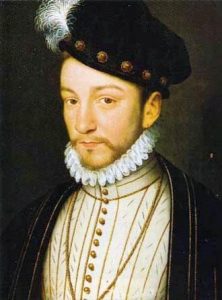Peaceful times
The peace of Longjumeau lasted only five months. At the court, the Catholics ruled again. Cardinal Charles de Lorraine was at the head of the royal council. Michel de l’Hospital had withdrawn after the queen blamed him for underestimating the Huguenot peril. In the provinces, the Catholics set up self-defence leagues. In Toulouse the king’s representative who brought the edict of pacification to the parliament was killed. Cities from which the Protestants had fled were readily occupied, and royal troops could not enter Protestant strongholds.
The royal power decided to put an end to religious tolerance. The rulings of Saint-Maur in September 1568 revoked the edict of Longjumeau, and called the Huguenots “criminals of lese-majesty and disturbers of public peace and quiet.” A spectacular procession was organised in Paris to prove that, as a very Christian king, Charles IX stood up for Catholicism.
Once again civil war in France affected international events, notably the uprising of Philippe II’s subjects in the Netherlands, who were called the “Gueux.” Their terrible repression led by the Duc d’Albe, caused considerable emotion in France. Each side received foreign help: the Catholics from Philippe II of Spain, Pope Pie V and the duke of Tuscany, and the Protestants from William of Nassau, prince of Orange with whom Louis de Condé and Gaspard de Coligny had signed an alliance) and Elizabeth I of England who financed the expedition of the palatine count Wolfgang of Bavaria to Burgundy in the Spring of 1569.
Louis de Condé and Gaspard de Coligny retreated to Burgundy and felt threatened. They escaped a kidnapping attempt and arrived in the Huguenot stronghold of La Rochelle in September 1568. They met up with the Gascons led by Jeanne d’Albret and her 15-year-old son Henri de Navarre, king Henri IV to be. It was the beginning of the third war of religion
War times
The third war of religion was especially long and confusing. Atrocities were many and battles involving great numbers were particularly bloody. The civil war spread abroad with contingents from Switzerland, Germany, Italy and England. Almost the whole kingdom was affected, and the country had grown terribly weak.
Among the battles taking place notably in the Poitou, Saintonge and Guyenne regions, two were won by the Catholics:
- On 13 march 1569 in Jarnac the Duc d’Anjou, King Henri II to be, won against Louis de Condé who was killed during the battle. He fell off his horse and broke his leg, as he was surrendering he was executed by one of Anjou’s officers. All Huguenot leaders were to be executed, but Gaspard de Coligny managed to escape and was met by Jeanne d’Albret. The latter introduced their new leaders to the troops, namely Henri de Navarre, and the 15-year-old son of Louis de Condé, Henri I of Bourbon: both princes of royal blood. Thanks to the additional German mercenaries, Gaspard de Coligny defeated Philippe Strozzi’s troops at La Roche d’Abeille -south of Limoges – in June 1569: all the prisoners were killed.
- At Monconcour, north of the Poitou region on 3 October 1563, the royal troops with the help of Swiss mercenaries, were 70,000 men strong, whereas the Huguenots had 16,000. It was a most bitter defeat for the Huguenots. Gaspard de Coligny was injured but managed to escape. The Swiss, allied to the royal troops, showed no mercy to the Germans, and all captives were killed.
In spite of these two defeats the Huguenots were not discouraged. Gaspard de Coligny went north and reached la Charité-sur-Loire. In June 1570 the Protestant army won the battle of Arnay-le-Duc. The front line threatened Montargis; thus the invasion of Paris without its royal troops seemed possible. Catherine de Medici asked for a cease-fire again, so that the moderates could regain their influence, to the demise of the de Guises faction.
The edict signed at Saint-Germain on 8 August 1570 marked a political reversal and a renewal of civilian tolerance by guaranteeing freedom of conscience, freedom of worship where it already existed on 1 August 1570; the Protestants were also awarded safe strongholds for two years: la Rochelle, Cognac, La Charité-sur-Loire and Montauban, where they could keep garrisons maintained by the king.
In 1570, Catherine de Medici thought she had finally managed to pacify the kingdom. But the peace of Saint-Germain was criticised by the Pope, deemed the “devil’s peace” and by the ambassador of Spain, nor was it accepted by the Catholics because of the guarantees given to the rebels, indeed the king had lost his power over four cities, which was unacceptable.








